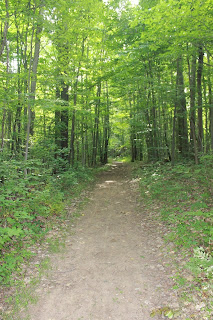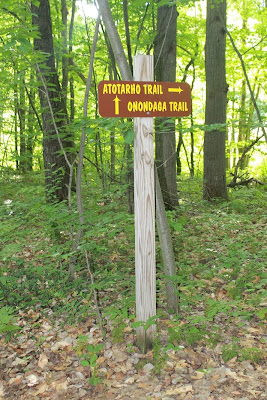
The Iroquois Wildlife Refuge is not lacking in things to do for the nature lover, whether it’s observing migrating birds from the lookouts, paddling Oak Orchard Creek, or hiking on the Refuge’s trails.
When it comes to those hikes, Swallow Hollow – and its famous boardwalk -- is far and away the most popular trail, with the Kanyoo and Feeder trails coming in next due to their accessibility to Route 77.
The least popular trail of the trails is Onondaga. That is by no means a reflection of the quality of the experience to be had there. Instead, it comes down to the trail being off the beaten path, which makes it a real hidden gem.
Getting there
The Onondaga Trail is located on Sour Springs Road, which is parallel to and just to the east of Route 63. To get there, you have to take 63 to Roberts Road to Sour Springs, heading north on Sour Springs Road.
You cannot access the trailhead if you traveled south on Sour Springs after visiting the two popular overlooks at Ringneck Marsh because the Sour Springs bridge that crosses Oak Orchard Creek has been out for almost 20 years now.
Sour Springs is a stone and gravel road which is immaculately maintained. On my recent trip to the trail, the road was smooth with nary a pothole, so you don’t have to worry about harming your car.
The parking lot for the trail is located across the street from the lone – and apparently abandoned – house on Sour Springs Road, and right next to the sign telling motorists that the bridge is out 1,000 feet ahead.
The stone lot allows parking for approximately 12 cars. I have never seen more than 3 cars in the lot (my vehicle included). If there ever is overflow (which would occur on one of the Refuge’s guided hikes), you could certainly park roadside.
Hiking through the swamp
The trail is 1.2 miles one-way. It’s not a loop, so you will come to the end and turn around, hiking back from where you came.
The first quarter mile of the hike is quite interesting. You walk upon a gravel dike that cuts through the Onondaga Swamp, which is approximately 60 acres in size. It is not a marsh – which is typically water with cattails, reeds, and sedges. Instead, it is swamp – wood vegetation like maples occasionally pop up through the water which is dominated by small, brushy plants.
While this won’t afford you the chance to see vast areas of open water to watch flocks of geese and ducks like you would elsewhere on the refuge, it gives you the ability to see a wider variety of wildlife.
On a July hike, from that dike I observed and heard swamp sparrows and numerous species of warblers in the swamp.
It was the herpetological creatures, though, that really caught my attention and that of my four-year- old hiking buddy. We encountered green, leopard, pickerel and bull frogs in great numbers (in the early spring the swamp is a deafening cacophony of spring peepers).
We also observed at least two dozen painted turtles popping their heads out of the water. It was their cousin, the snapping turtle, that turned our heads. Along that dike we found nearly 20 snapper nests that recently saw their eggs hatch and their babies head off into the water. 20! If each underground nest had a good clutch of eggs (and this happens every year), just imagine how many snappers are in that swamp!
We also encountered two northern water snakes – one was well over two-feet long and exceptionally fat and it surprised us by disappearing into a small burrow in the ground. If you encounter one of these reptiles on the trail, don’t touch it – water snakes are mean and will bite (they are not poisonous).
Hiking through the woods
The longest portion of the hike takes you through lowland forests. It has a flat, wide trail with no incline which makes for a nice, family-friendly stroll in a quiet, secluded forest of great variety.
The first portion – nearest the swamp – is young-growth woods, with a few larger willows and yellow birches. As head further into the woods, the trees get older, larger and more diverse (maples become plentiful) and the soil gets richer, showing a wider variety of plant life.
The forest on the north side of that trail features many low pockets that would typically hold a little water well into summer, but in this drought they were bone dry. This did not force my hand to applying bug spray to my daughter as the mosquitos were a non-issue – but in any other year, they would be a problem, so be prepared! While mosquitos weren’t a problem, deer flies were and they are every summer, so be sure to wear a hat.
Bring a pair of binoculars with you, as the forest is chock-full of songbirds such as thrashers, veeries, wood thrushes, vireos, and warblers. On our hike last week we heard and saw nearly two dozen species of forest birds.
Also, be as quiet as possible, as you might encounter turkeys, foxes, and coyotes in this stretch. For years, I’ve thought that if you were going to see secretive bobcats and bears in the region, the Onondaga swamp and the adjoining forests would be the place to see them. You’re really off the beaten path here.
A nice little side trail
About half-way through the hike, you will encounter a sign that directs you to the Atotarho Trail to your right. Take that short little jaunt. It’s a loop of less than a quarter mile in length that will lead you back to the Onondaga trail.
I really like this section because there is a dramatic change in plant life. The soil is much richer and you will find a few unexpected hemlock trees and a plethora of wild flowers (especially in the spring). In that stretch I’ve found partridgeberries, trilliums, Canada mayflowers, mayapple, Solomon’s seal, and parnassus to name a few – it’s a bevy of flowers that prefer high-quality woodlands!
The Onondaga Trail is a wonderful place to visit, one made for all seasons. The spring and summer feature reptiles, amphibians, wildflowers, and songbirds in great numbers while the fall shows off many striking colors from the mixed hardwoods. And, as long as Sour Springs is accessible in the winter months, it’s a great place to snowshoe or do some cross country skiing.
It real is a gem – and an underutilized one at that. Chance are, when you visit you will have the forest all to yourself – and your animals friends.
Bob Confer is a Gasport resident. His column, Exploring the Niagara Frontier, is published every Thursday on All WNY News.
From the 14 July 2016 All WNY News




No comments:
Post a Comment